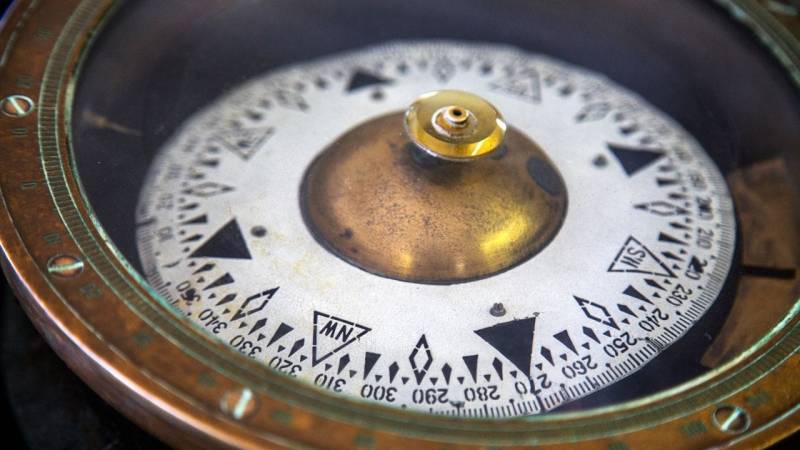
Navigation and orientation without a compass – these 11 methods will help you accurately determine the cardinal directions
👉 The key facts from this guide
- The sun can be used for rough orientation, as it always rises in the east and sets in the west.
- The time can be used to determine the direction, by pointing the hour hand towards the sun.
- The North Star is a reliable indicator for north in the Northern Hemisphere.
- The position and phase of the moon can also be used for orientation.
- Some plants, such as thistle lettuce, grow towards the sun and can be used to determine the directions.
- Satellite dishes are usually oriented towards south-southeast and can serve as a help for orientation.
Imagine you have to determine the cardinal directions in the wilderness.
You have a map, but no compass.
At first, it may sound difficult – but what if it's easy for you?
In fact, you can orient yourself by nature, such as the sun, stars, moon, or trees.
And I'll show you which methods are suitable for navigation without a compass in the next 5 minutes.
People Are Keen to Learn More About Navigation and Orientation
In survival, navigation with a compass and map is a core topic. However, a compass can break, or you may lose it.
Look: The topic of navigation (with or without a compass) is ranked second in one of my surveys:
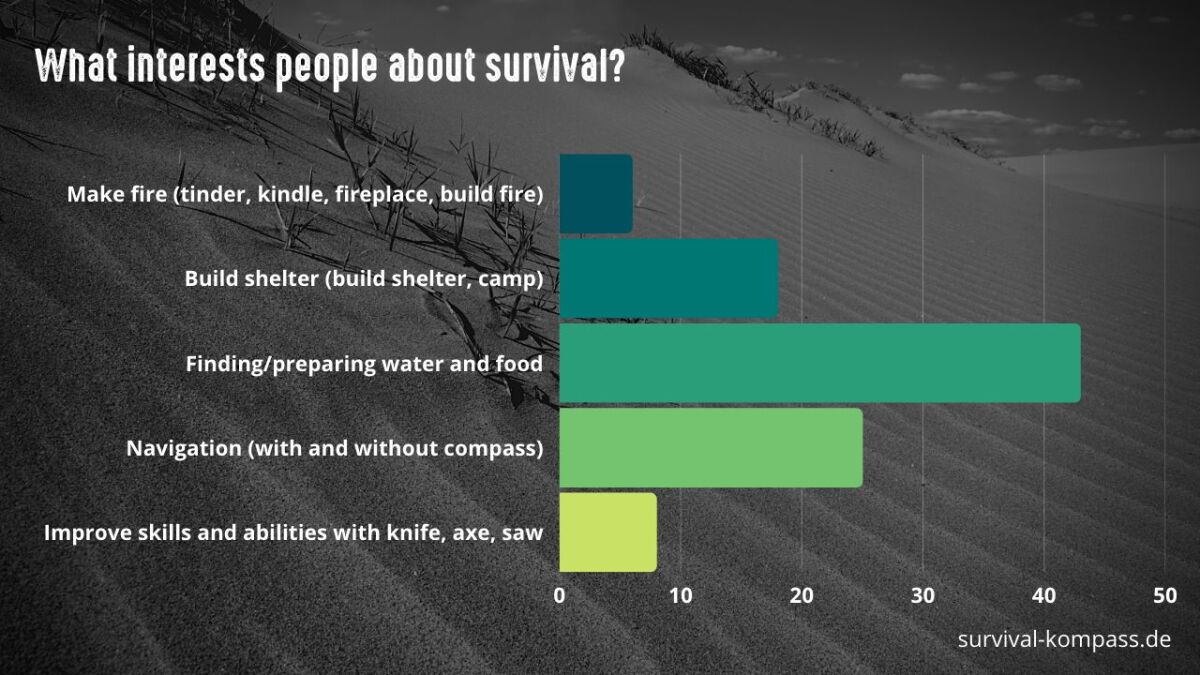
What does this tell me? It's a crucial topic, and so we're going to tackle it now.
Ready? Great.
In an emergency, you might ask yourself:
How do you find North without a compass?
First, you need to know that the sun rises in the east, is in the south at noon, and sets in the west.
Furthermore, I want to encourage you not to rely on just one method.
Use several methods simultaneously and combine them. Then you'll be a genius at determining cardinal directions.
But now, let's start with orientation by the sun.
1. Rough Orientation by the Sun
- You know that the sun rises in the east. So, if you have the sun behind you in the morning, you know where east is. You're looking towards the west.
- Look at the sun between 12 and 1 pm. In winter, the sun is at its highest at 12 pm, and in summer at 1 pm. If you're moving towards the sun, you're walking south.
Point 1 is the same in the Northern and Southern Hemispheres. The sun rises in the east everywhere on earth.
However, for point 2, if you're in the Southern Hemisphere, you have to swap south with north. If you're right at the equator, the second method won't help you because the sun is directly above you.
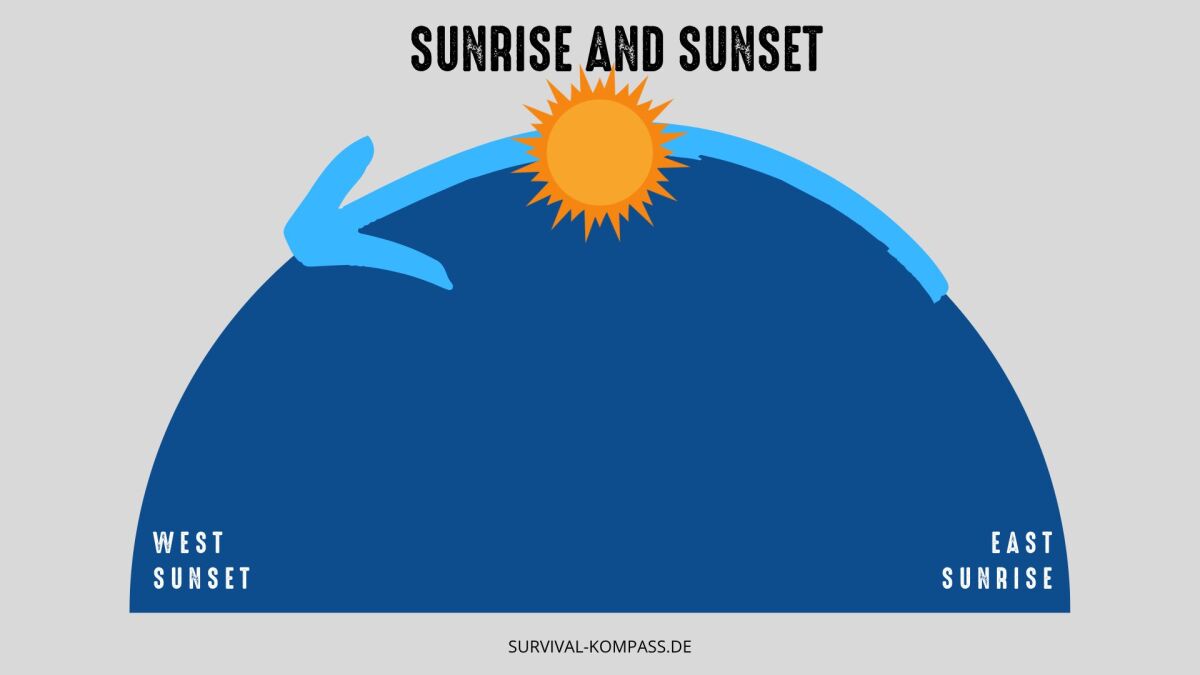
2. How to Determine Cardinal Directions with a Clock?
If you have a clock with hands, determining cardinal directions is effortless. With this method, you can orient yourself effortlessly without a compass.
Proceed as follows:
- Point the hour hand towards the sun
- In daylight saving time, the south is now between the hour hand and the one o'clock mark
- In standard time, the south is between the hour hand and the 12 o'clock mark
- Always half the smaller angle between the hour hand and the 12 - that is the south direction
Here is an image to explain:
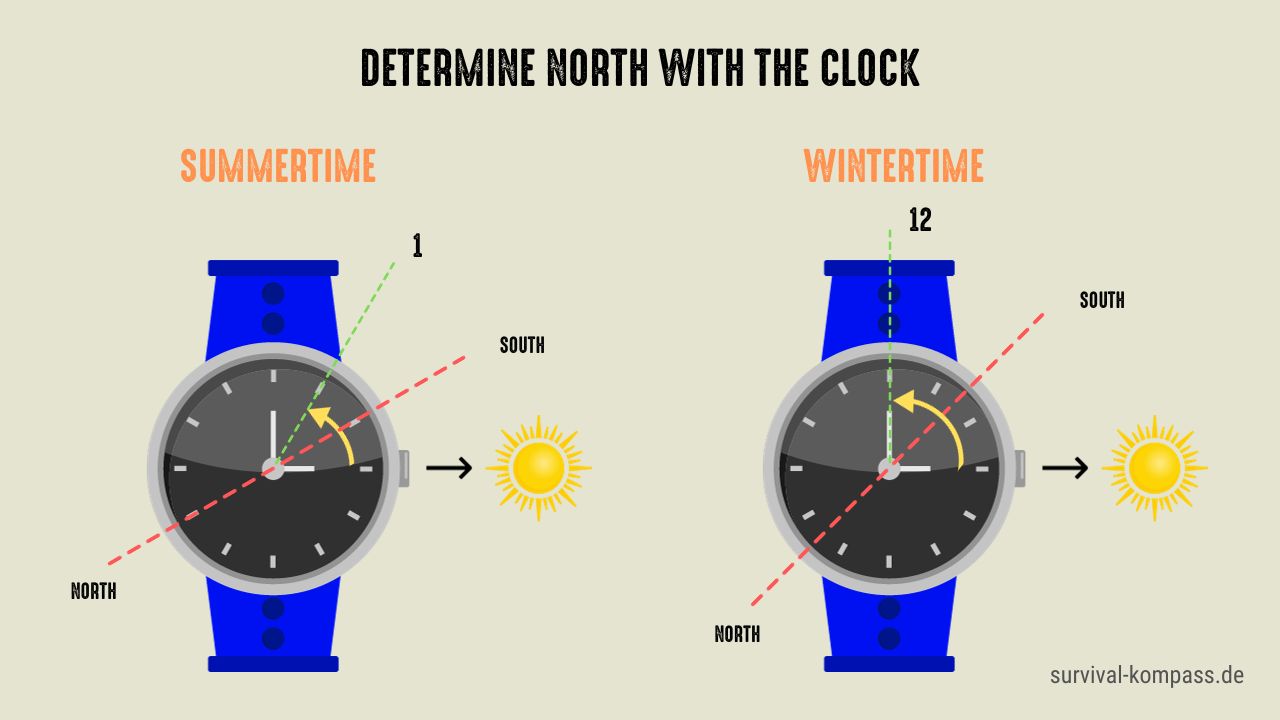
Pretty simple, right?
One more note: The method is not entirely accurate because the sun does not always stand exactly in the south at noon in every location.
And it's important to know, as I mentioned before: in the morning, you have to look for the marks clockwise and in the afternoon, counterclockwise.
Furthermore, the sun is not always visible. But that is rather a small problem because you can tell where the sun is by looking at the shadows.
Here are two examples to determine the directions in the morning and evening:
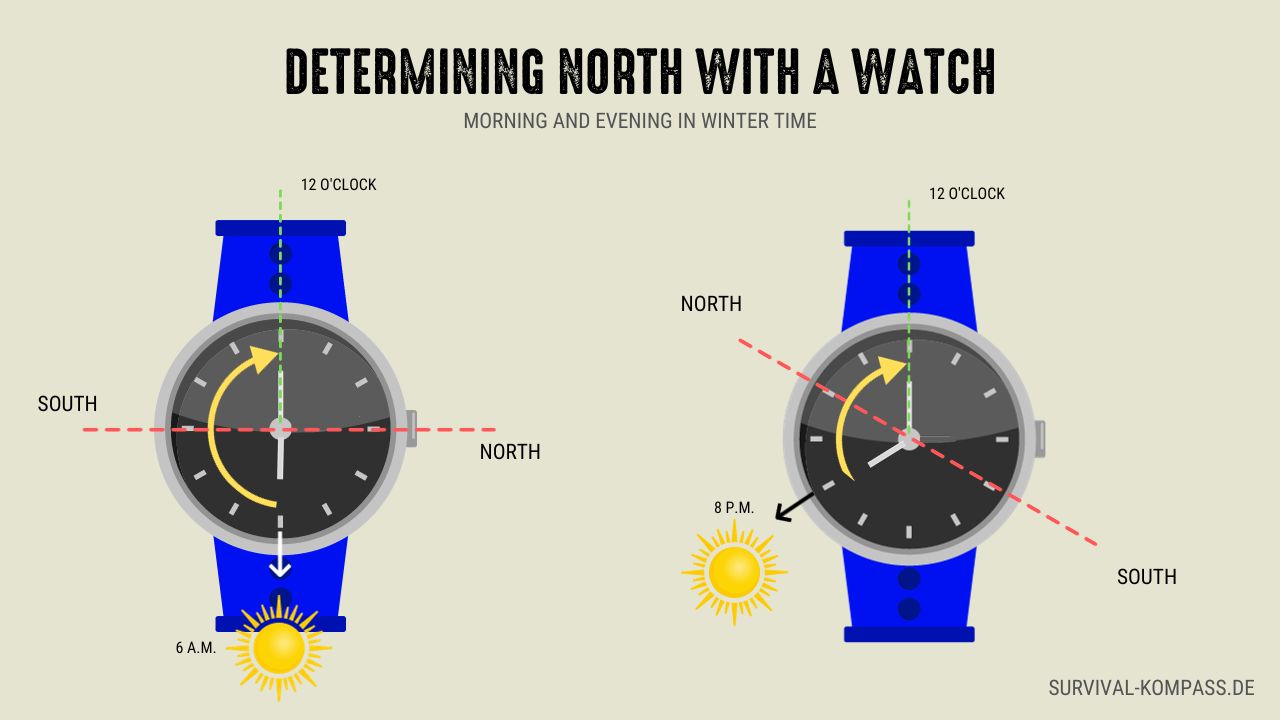
3. Determine North with the Sun and a Stick
Navigate without a compass using the shadow stick method. The method is brilliant and you should definitely practice it.
Proceed as follows:
- Insert a stick vertically into the ground.
- Mark the end of the shadow with a stone.
- Wait 30 minutes and mark the end one of the shadow again with a stone.
- Repeat the process at least three times, preferably four to five times.
- Then connect the markings with a line - you get the west-east line when you stand between the stick and the line.
- North is now at a 90-degree angle to this line.
The graphic here illustrates the method:
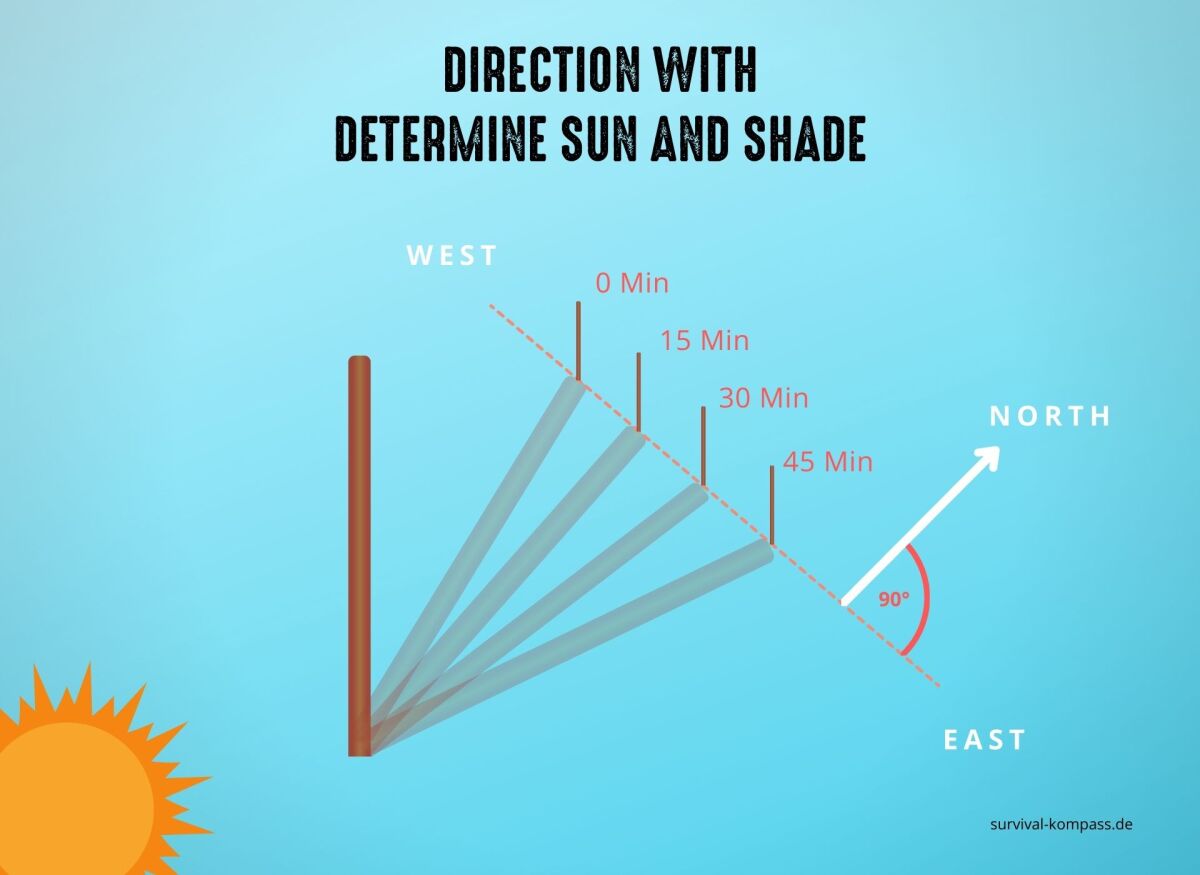
In the Southern Hemisphere, you have to swap north and south.
Since the shadow stick method is so great, I have written an extra guide for it. There you will learn the method in detail and how to avoid mistakes that make the method inaccurate.
4. The Pole Star - How can you navigate with the stars?
With the help of star constellations, you can determine the directions very precisely without a compass. You use the Pole Star, also called the North Star, for this. Sailors have been doing this for thousands of years.

For this, look for the constellation Big Dipper because you can see this constellation in the sky all year round (if it's cloudless). The Big Dipper looks like a rectangle with a handle.
Now, if you take the two outer stars of the rectangle and extend this line five times in the same direction, you will come across the Pole Star.
You can recognize the North Star by the fact that it shines brighter than many other stars in its surroundings.
Additionally, it is the last star of the handle of the constellation Little Dipper. The Little Dipper rotates around this star at night.
And one thing about the North Star: It is ALWAYS in the north.
To determine north, draw a straight line from the North Star to the horizon. Where the line meets the horizon is north.
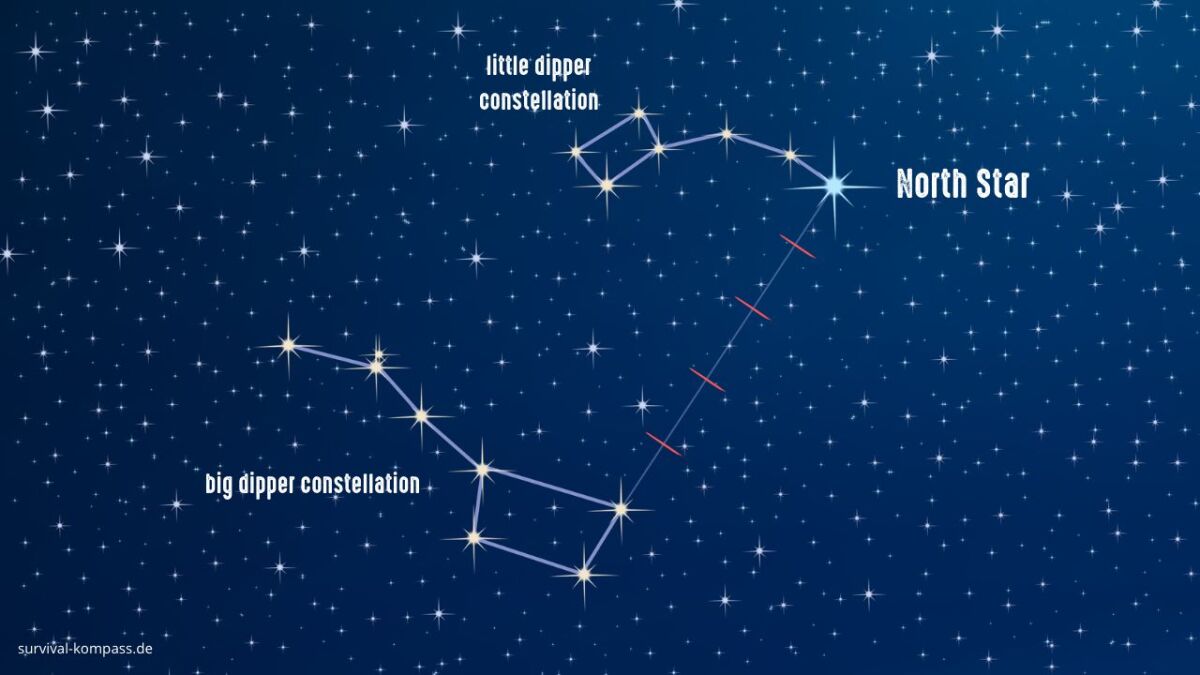
One more piece of information: the method is only almost exact because the North Star is currently 0.7 degrees away from the northern celestial pole.
Since the earth wobbles (a full wobble takes about 25,700 years), the North Star will not always remain in the north. In the year 2102, it will have the closest distance to our axis and then move away again. In about 12,000 years, Vega in the constellation Lyra will become the new North Star. They alternate.
Here is a good video about the North Star:
Attention: This method only works in the Northern Hemisphere. You will never see the North Star in the Southern Hemisphere.
But there is also a solution for that. Keep reading.
If you are in the Southern Hemisphere, you will not find a star that is exactly at the southern celestial pole. You must look for the constellation Southern Cross.
Extend the longitudinal axis of the Southern Cross by a factor of 4.5, and you will be in the polar region of the southern sky. Imagine a vertical line to the horizon and you will find south.
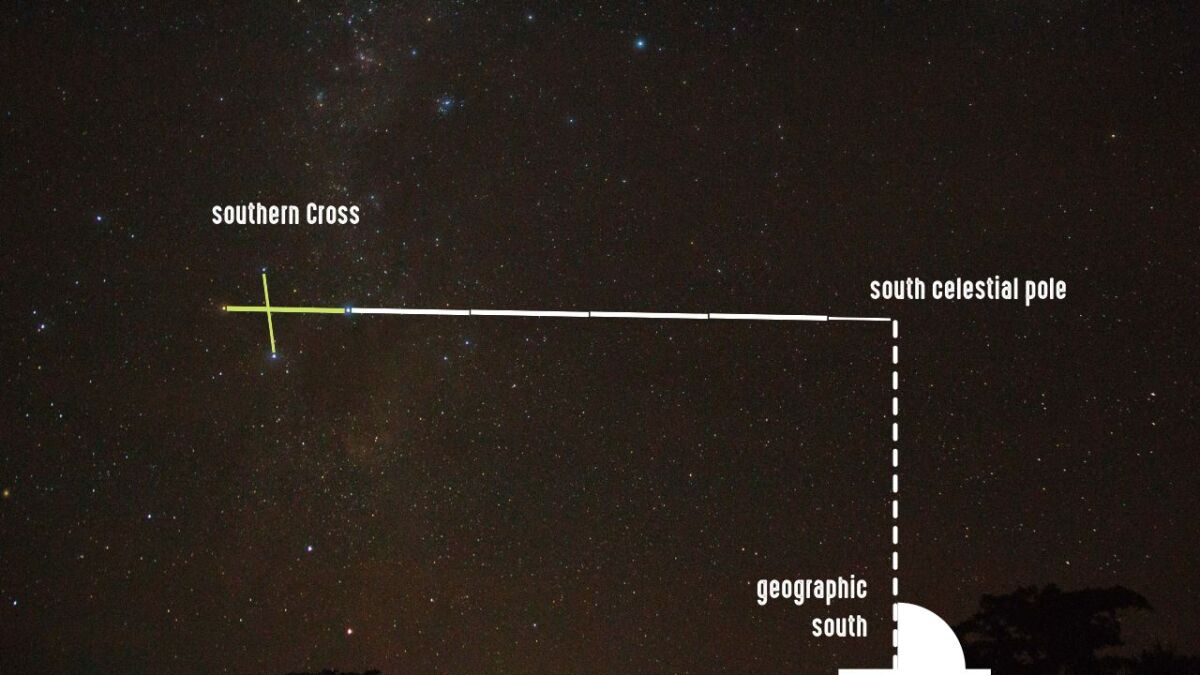
5. Navigating without the North Star
If you look at the stars, you can determine in which direction you are looking based on the movement of the earth.
Fix your eyes on two distant points, such as two trees. Or find two sticks, one slightly longer than the other. Then stick the sticks into the ground vertically, one meter apart (like a sight). Now find a star that is exactly aimed with your sight and wait a bit.
- If the star moves to the left, you are facing north.
- If the star moves to the right, you are facing south.
- If the star rises, you are facing east.
- If the star moves down, you are facing west.
6. Navigation by the Moon
You want to orient yourself at night without a compass and only see the moon? Then learn how to determine the direction based on the moon's position.
To use this method, you have to know the method of orientation with a watch and the sun.
Proceed as follows:
- Imagine the moon as a cake consisting of 12 slices. Full moon means 12/12 (numerator/denominator). Half moon 6/12, crescent moon 3/12 and new moon 0/12 (not visible).
- Determine whether the moon is waxing or waning. With a waxing moon, the round side faces right, with a waning moon, it faces left.
This is what it looks like at night sky:
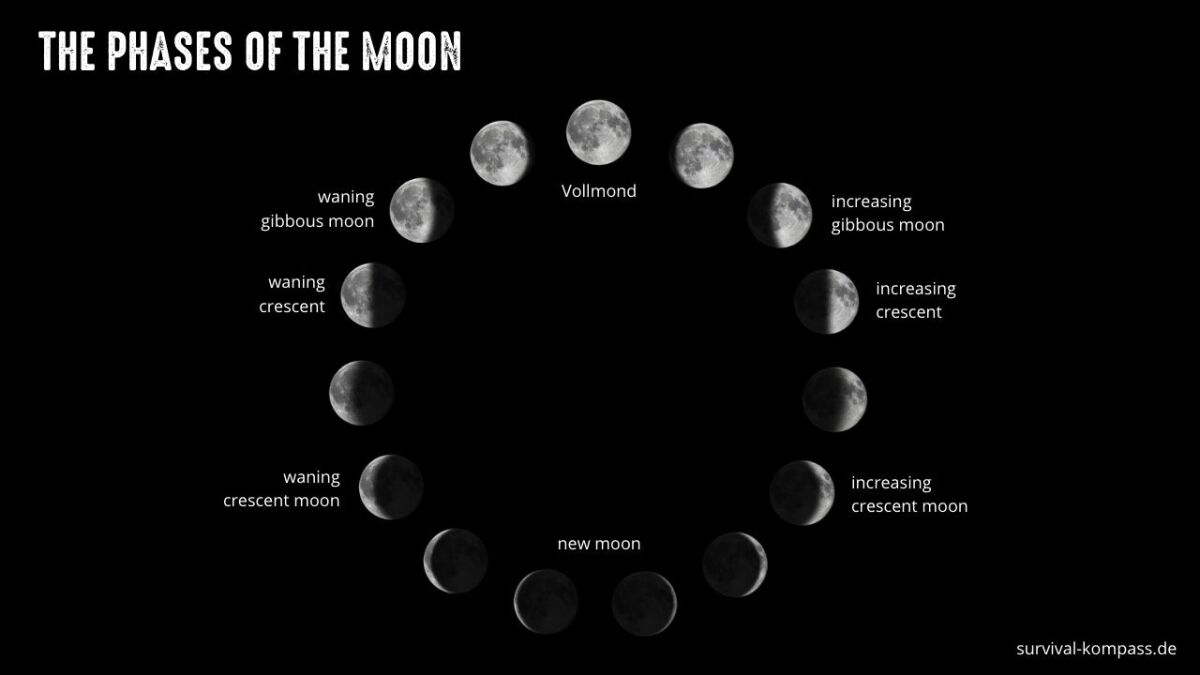
- Now look at the clock and determine what time it is.
- For a waning moon, add the moon phase counter to the current time.
- For a waxing moon, subtract the moon phase counter from the current time.
- The sun is in the same position as the moon during the day at the calculated time.
Now that you know where the sun is during the day and have a time, you can use the orientation with a clock and the sun method to determine the cardinal directions.
Note: In daylight saving time, subtract one hour.
Here's an example:
- It's 1 a.m. and the moon is a waxing half-moon, which has a value of 6/12.
- 1 a.m. minus 6 hours results at 7 p.m.
- If the clock's hour hand is pointing at the moon (i.e., the sun at 7 p.m.), north is between 9 and 10 o'clock.
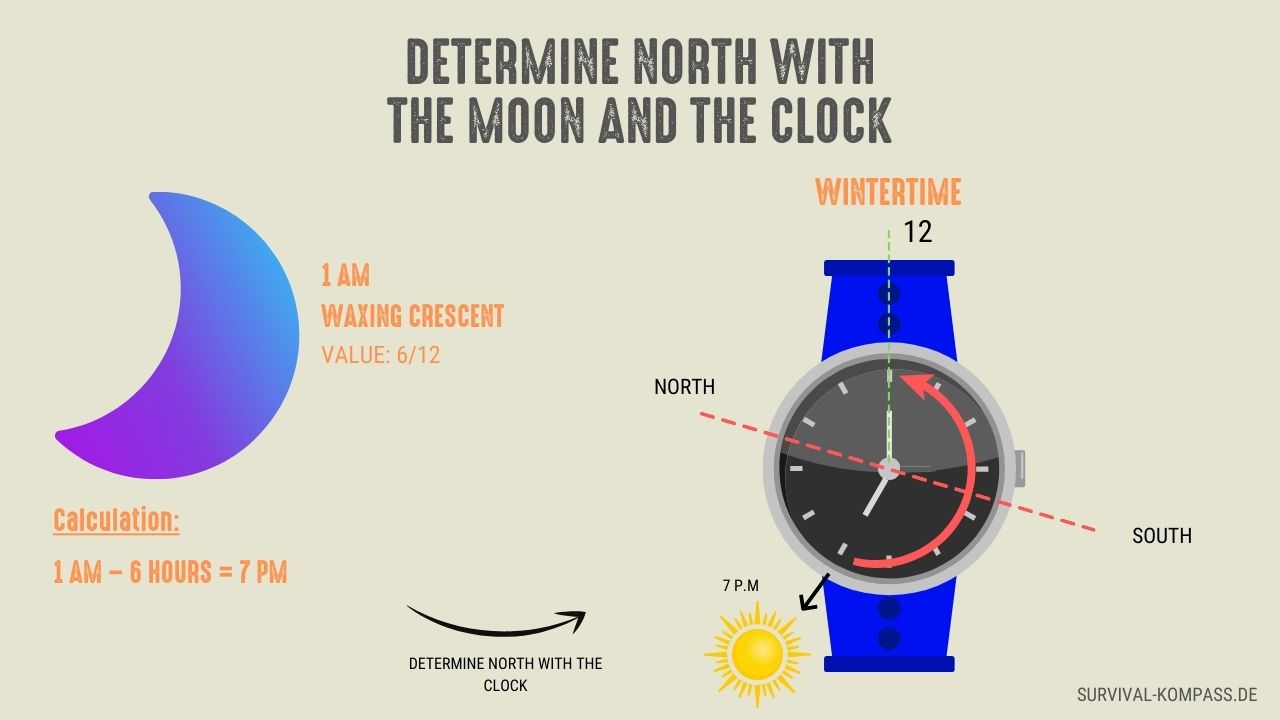
7. Ants
Did you know that ants warm themselves up in the sun and then run back into their nest to heat it up?
They really do this, and they need warmth to get the ant colony going.
That's why ants often build their hills facing south. This means that trees on which ant hills are built face north.

8. Trees
As a forest ranger, you know that the predominant wind in Europe comes from the west.
You can use this knowledge to navigate without a compass. Look at the trees.
Especially with freestanding trees, you typically see that they are slightly tilted to the east. Wind and weather have caused them to grow this way. So orient yourself based on the direction in which the trees are tilted.

9. Plants
Usually, the leaves on the south side of a plant are denser and thicker.
But there are even better identifying features. Take a look at the next plant.
The prickly lettuce, also known as compass plant or fence lettuce, can help you navigate without a compass.
It grows almost everywhere, such as on the roadside. The plant grows 30 to 120 cm high and if you break off a stem, white latex comes out.
To determine the cardinal directions with the thistle lettuce, we look at its leaves.
These turn / grow towards the sun. The tips of the leaves often point in a north-south direction. Typically, the tips and narrow sides point north-south, and the blade points east-west.
These compass plants, such as the thistle lettuce, do this for a reason: they want to avoid the hot midday sun.

Other compass plants include:
- the compass plant (Silphium laciniatum)
- the tansy (Tanacetum vulgare)
- Some irises (Iris)
- the goldilocks aster (Aster linosyris)
10. In which direction does moss grow?
On tree trunks, rocks or buildings, moss grows more on the north side. This is because moss prefers to grow where it is moister and not sunny.
However, I must tell you that this method is imprecise. Sometimes even very imprecise. Please do not rely on it.
But maybe in your emergency there is no more precise method, and you have to rely on it.
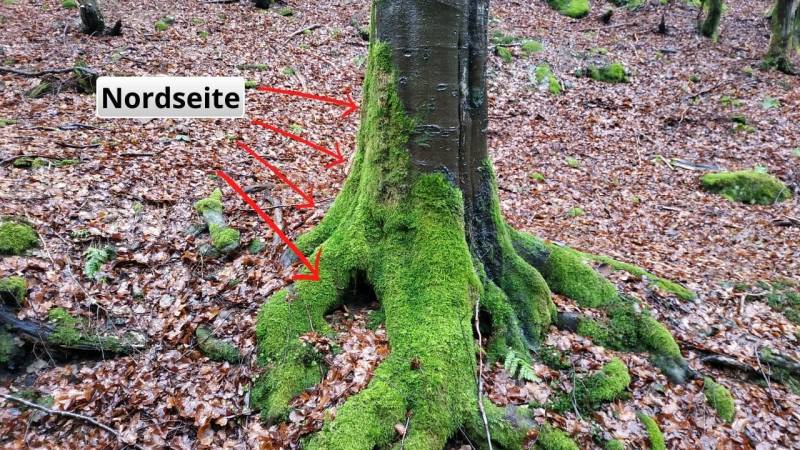
Orientation in the wilderness is crucial, but not every myth helps. We clarify: The truth about moss and the north direction – what you really need to know!
11. Satellite dishes
If you want to roughly determine the cardinal directions in the city, then look for a few satellite dishes.
Most satellite dishes are oriented towards South-Southeast.
However, this only applies in the Northern Hemisphere. In the Southern Hemisphere, the satellite dishes are oriented towards North-Northeast.
Great trick to orient yourself without a compass, isn't it?
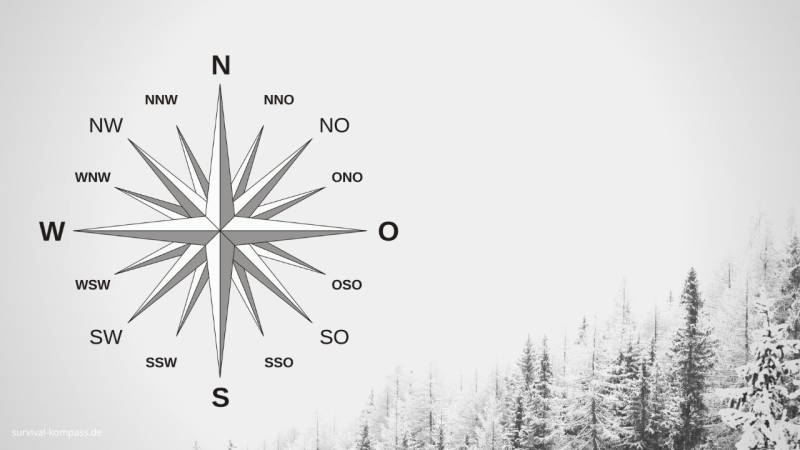
Those were all 11 methods for navigating and orienting without a compass.
Finally, let me show you how to build your own compass.
Building your own compass
Don't have a compass? Then build one yourself.
All you have to do is magnetize a type of needle and let it float on a liquid.
The result: one end of the floating needle will point north. You have to determine which side is north with other methods.
Here are some tips on how to magnetize the needle:
- Run a magnet over the needle several times in the same direction
- Use hardened steel as the needle, soft wire is not suitable
- If you don't have a magnet, run the pocket knife over the needle several times (20-50 times) in the same direction
- A paper clip is also suitable as a needle
- If the needle doesn't float well, place a thin sheet of paper underneath it
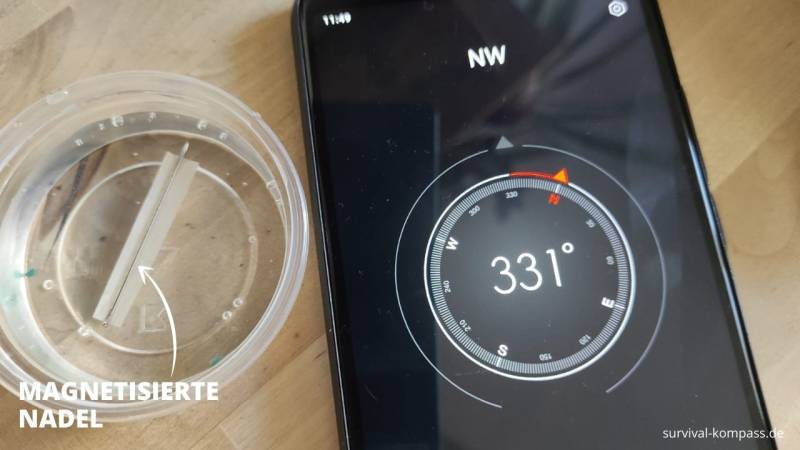
Summary
One thing to know about orienting in a natural environment, such as ant hills or moss: these methods are not definitive.
Always use multiple methods simultaneously to determine the cardinal directions accurately.
For example, don't rely on a single ant hill, but also look at the position of the sun and the growth of the trees. This will give you an excellent estimate.
The methods with the sun and the clock or the stars, on the other hand, are precise.
Do you know any other methods for orienting and navigating without a compass? Then write it in the comments.


Author of the guide
Martin Gebhardt
Hey, I'm Martin. On my blog, you will learn the basics and numerous details about living in the wild. I think survival, bushcraft and the good life in nature are the keys to happiness. Find me here on Instagram or on YouTube. You can find more about my mission on the About Me page.
Was this guide helpful?
75 people found this guide helpful.
5.00 out of 5 points (75 Ratings)
Comments (0)
This post may contain affiliate links. So if you click on the links and make a purchase, I will receive a small commission at no additional cost to you. Click here, to learn more about it.


